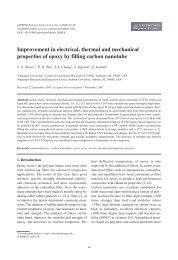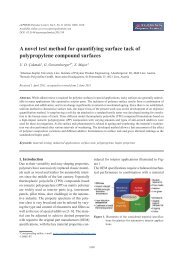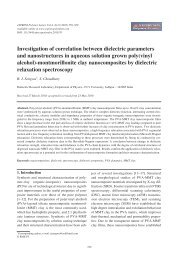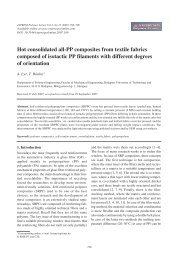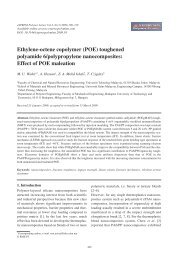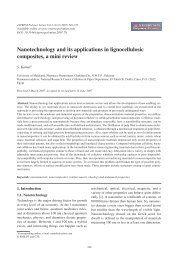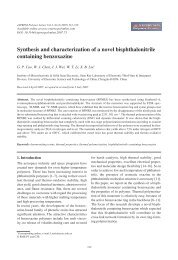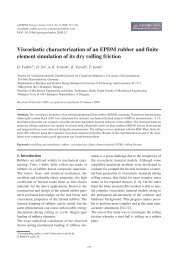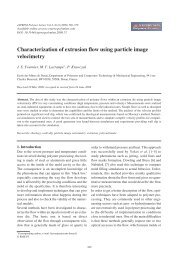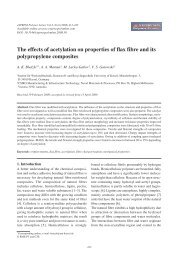Starch-based completely biodegradable polymer materials
Starch-based completely biodegradable polymer materials
Starch-based completely biodegradable polymer materials
Create successful ePaper yourself
Turn your PDF publications into a flip-book with our unique Google optimized e-Paper software.
Lu et al. – eXPRESS Polymer Letters Vol.3, No.6 (2009) 366–375<br />
2. Structure and properties of starch<br />
<strong>Starch</strong> is mainly composed of two homo<strong>polymer</strong>s<br />
of D-glucose [8]: amylase, a mostly linear α-<br />
D(1, 4’)-glucan and branched amylopectin, having<br />
the same backbone structure as amylose but with<br />
many α-1, 6’-linked branch points (Figure 1). There<br />
are a lot of hydroxyl groups on starch chains, two<br />
secondary hydroxyl groups at C-2 and C-3 of each<br />
glucose residue, as well as one primary hydroxyl<br />
group at C-6 when it is not linked. Evidently, starch<br />
is hydrophilic. The available hydroxyl groups on<br />
the starch chains potentially exhibit reactivity specific<br />
for alcohols. In other words, they can be oxidized<br />
and reduced, and may participate in the formation<br />
of hydrogen bonds, ethers and esters [12].<br />
<strong>Starch</strong> has different proportions of amylose and<br />
amylopectin ranging from about 10–20% amylose<br />
and 80–90% amylopectin depending on the source<br />
[13]. Amylose is soluble in water and forms a helical<br />
structure [14]. <strong>Starch</strong> occurs naturally as discrete<br />
granules since the short branched amylopectin<br />
chains are able to form helical structures which<br />
crystallize. <strong>Starch</strong> granules exhibit hydrophilic<br />
properties and strong inter-molecular association<br />
via hydrogen bonding formed by the hydroxyl<br />
groups on the granule surface.<br />
Owing to its hydrophilicity, the internal interaction<br />
and morphology of starch will be readily changed<br />
by water molecules, and thereby its glass transition<br />
temperature (T g ), the dimension and mechanical<br />
properties depend on the water content. T g of native<br />
starch can be as low as 60 to 80°C when the weight<br />
fraction of water is in the range 0.12 to 0.14, which<br />
allows starch to be successfully injection moulded<br />
to obtain thermoplastic starch <strong>polymer</strong>s in the presence<br />
of water [15]. On the other hand, the hydrophilicity<br />
of starch can be used to improve the<br />
degradation rate of some degradable hydrophobic<br />
<strong>polymer</strong>s, which will be shown in 3.1.1.<br />
<strong>Starch</strong> is totally <strong>biodegradable</strong> in a wide variety of<br />
environments. It can be hydrolyzed into glucose by<br />
microorganism or enzymes, and then metabolized<br />
into carbon dioxide and water [16]. It is worth noting<br />
that carbon dioxide will recycle into starch<br />
again by plants and sunshine. <strong>Starch</strong> itself is poor in<br />
processability, also poor in the dimensional stability<br />
and mechanical properties for its end products<br />
[17]. Therefore, native starch is not used directly.<br />
3. Preparation of starch-<strong>based</strong><br />
<strong>biodegradable</strong> <strong>polymer</strong>s<br />
To improve the properties of starch, various physical<br />
or chemical modifications of starch such as<br />
blending, derivation and graft co<strong>polymer</strong>ization<br />
have been investigated.<br />
Figure 1. Molecular structure of starch<br />
367




